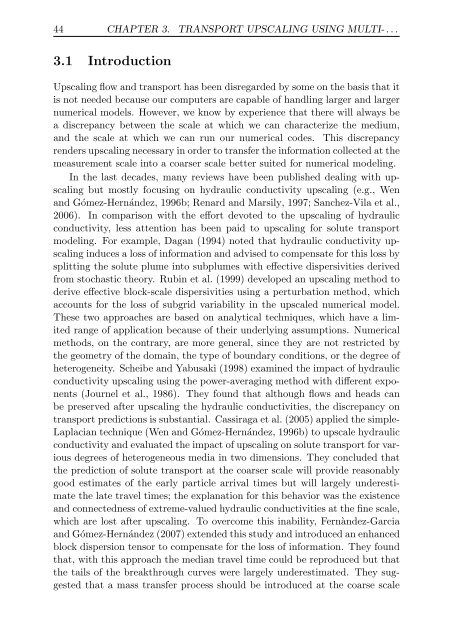Upscaling and Inverse Modeling of Groundwater Flow and Mass ...
Upscaling and Inverse Modeling of Groundwater Flow and Mass ...
Upscaling and Inverse Modeling of Groundwater Flow and Mass ...
You also want an ePaper? Increase the reach of your titles
YUMPU automatically turns print PDFs into web optimized ePapers that Google loves.
44 CHAPTER 3. TRANSPORT UPSCALING USING MULTI- . . .<br />
3.1 Introduction<br />
<strong>Upscaling</strong> flow <strong>and</strong> transport has been disregarded by some on the basis that it<br />
is not needed because our computers are capable <strong>of</strong> h<strong>and</strong>ling larger <strong>and</strong> larger<br />
numerical models. However, we know by experience that there will always be<br />
a discrepancy between the scale at which we can characterize the medium,<br />
<strong>and</strong> the scale at which we can run our numerical codes. This discrepancy<br />
renders upscaling necessary in order to transfer the information collected at the<br />
measurement scale into a coarser scale better suited for numerical modeling.<br />
In the last decades, many reviews have been published dealing with upscaling<br />
but mostly focusing on hydraulic conductivity upscaling (e.g., Wen<br />
<strong>and</strong> Gómez-Hernández, 1996b; Renard <strong>and</strong> Marsily, 1997; Sanchez-Vila et al.,<br />
2006). In comparison with the effort devoted to the upscaling <strong>of</strong> hydraulic<br />
conductivity, less attention has been paid to upscaling for solute transport<br />
modeling. For example, Dagan (1994) noted that hydraulic conductivity upscaling<br />
induces a loss <strong>of</strong> information <strong>and</strong> advised to compensate for this loss by<br />
splitting the solute plume into subplumes with effective dispersivities derived<br />
from stochastic theory. Rubin et al. (1999) developed an upscaling method to<br />
derive effective block-scale dispersivities using a perturbation method, which<br />
accounts for the loss <strong>of</strong> subgrid variability in the upscaled numerical model.<br />
These two approaches are based on analytical techniques, which have a limited<br />
range <strong>of</strong> application because <strong>of</strong> their underlying assumptions. Numerical<br />
methods, on the contrary, are more general, since they are not restricted by<br />
the geometry <strong>of</strong> the domain, the type <strong>of</strong> boundary conditions, or the degree <strong>of</strong><br />
heterogeneity. Scheibe <strong>and</strong> Yabusaki (1998) examined the impact <strong>of</strong> hydraulic<br />
conductivity upscaling using the power-averaging method with different exponents<br />
(Journel et al., 1986). They found that although flows <strong>and</strong> heads can<br />
be preserved after upscaling the hydraulic conductivities, the discrepancy on<br />
transport predictions is substantial. Cassiraga et al. (2005) applied the simple-<br />
Laplacian technique (Wen <strong>and</strong> Gómez-Hernández, 1996b) to upscale hydraulic<br />
conductivity <strong>and</strong> evaluated the impact <strong>of</strong> upscaling on solute transport for various<br />
degrees <strong>of</strong> heterogeneous media in two dimensions. They concluded that<br />
the prediction <strong>of</strong> solute transport at the coarser scale will provide reasonably<br />
good estimates <strong>of</strong> the early particle arrival times but will largely underestimate<br />
the late travel times; the explanation for this behavior was the existence<br />
<strong>and</strong> connectedness <strong>of</strong> extreme-valued hydraulic conductivities at the fine scale,<br />
which are lost after upscaling. To overcome this inability, Fernàndez-Garcia<br />
<strong>and</strong> Gómez-Hernández (2007) extended this study <strong>and</strong> introduced an enhanced<br />
block dispersion tensor to compensate for the loss <strong>of</strong> information. They found<br />
that, with this approach the median travel time could be reproduced but that<br />
the tails <strong>of</strong> the breakthrough curves were largely underestimated. They suggested<br />
that a mass transfer process should be introduced at the coarse scale


